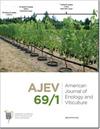Effects of Colored Shade Nets on Grapes and Leaves of Shine Muscat Grown under Greenhouse Conditions
IF 1.8
3区 农林科学
Q3 BIOTECHNOLOGY & APPLIED MICROBIOLOGY
引用次数: 3
Abstract
Greenhouse grapes are often ripened at very high temperatures in the south of China, however, high temperatures are detrimental to their ripening. To moderate the strong light and high temperature conditions of the growing environment, different colored shade nets (green, blue, and black) were used to cover Shine Muscat (Vitis labruscana L.H. Bailey × Vitis vinifera L.) grapes during the ripening period. Differences in the cooling effect, fruit appearance and taste, and leaf photosynthetic performance were analyzed. It was found that the shading treatment exerted a significant cooling effect, and the light transmittance of blue and green shade nets was significantly higher than that of the black shade net. Shine Muscat grapes grown under shading treatment conditions were found to have more consistent total soluble solids content and coloring. Shading was found to affect the aroma of grapes, but the effect of the green shade net treatment was lower. The shading treatments slightly alleviated the senescence of old leaves. The shading treatments were found to improve the consistency of Shine Muscat grape berries. Of the shading treatments, the green and blue shade nets were found to be most effective and can be used to cultivate high quality grapes.彩色遮阳网对温室条件下夏恩麝香葡萄和叶片的影响
在中国南方,温室葡萄通常在非常高的温度下成熟,然而,高温对其成熟是有害的。为了调节生长环境的强光和高温条件,在成熟期间使用不同颜色的遮阳网(绿色,蓝色和黑色)覆盖Shine Muscat (Vitis labruscana L.H. Bailey × Vitis vinifera L.)葡萄。分析了冷却效果、果实外观和味道以及叶片光合性能的差异。结果表明,遮荫处理具有显著的降温效果,且蓝色和绿色遮荫网的透光率显著高于黑色遮荫网。在遮阳处理条件下生长的Shine麝香葡萄被发现具有更一致的总可溶性固形物含量和颜色。遮荫对葡萄的香气有影响,但绿荫网处理的效果较低。遮荫处理对老叶的衰老有轻微的缓解作用。遮荫处理可以提高夏恩麝香葡萄果实的稠度。在遮荫处理中,绿色和蓝色遮荫网最有效,可用于培育优质葡萄。
本文章由计算机程序翻译,如有差异,请以英文原文为准。
求助全文
约1分钟内获得全文
求助全文
来源期刊

American Journal of Enology and Viticulture
农林科学-生物工程与应用微生物
CiteScore
3.80
自引率
10.50%
发文量
27
审稿时长
12-24 weeks
期刊介绍:
The American Journal of Enology and Viticulture (AJEV), published quarterly, is an official journal of the American Society for Enology and Viticulture (ASEV) and is the premier journal in the English language dedicated to scientific research on winemaking and grapegrowing. AJEV publishes full-length research papers, literature reviews, research notes, and technical briefs on various aspects of enology and viticulture, including wine chemistry, sensory science, process engineering, wine quality assessments, microbiology, methods development, plant pathogenesis, diseases and pests of grape, rootstock and clonal evaluation, effect of field practices, and grape genetics and breeding. All papers are peer reviewed, and authorship of papers is not limited to members of ASEV. The science editor, along with the viticulture, enology, and associate editors, are drawn from academic and research institutions worldwide and guide the content of the Journal.
 求助内容:
求助内容: 应助结果提醒方式:
应助结果提醒方式:


